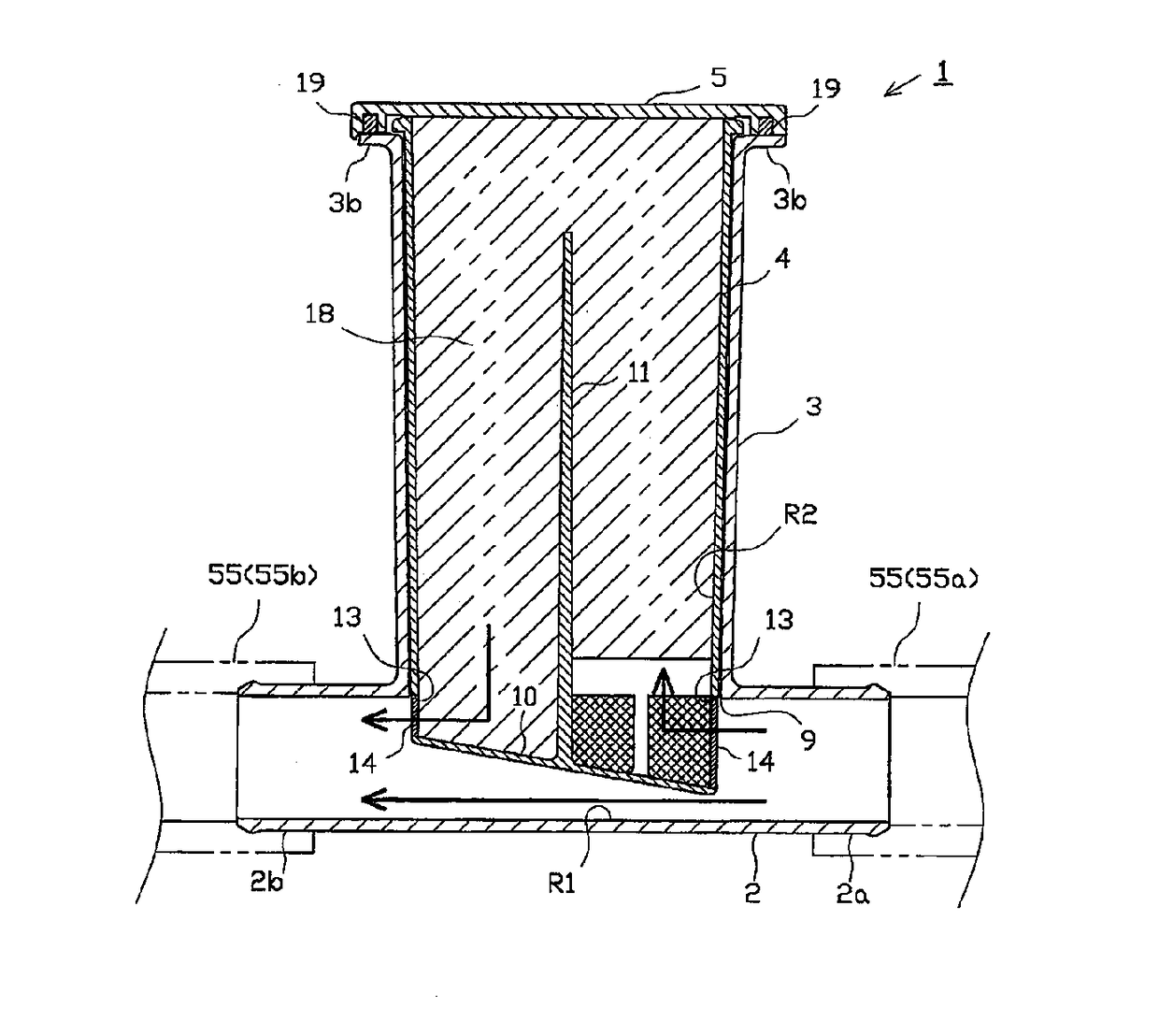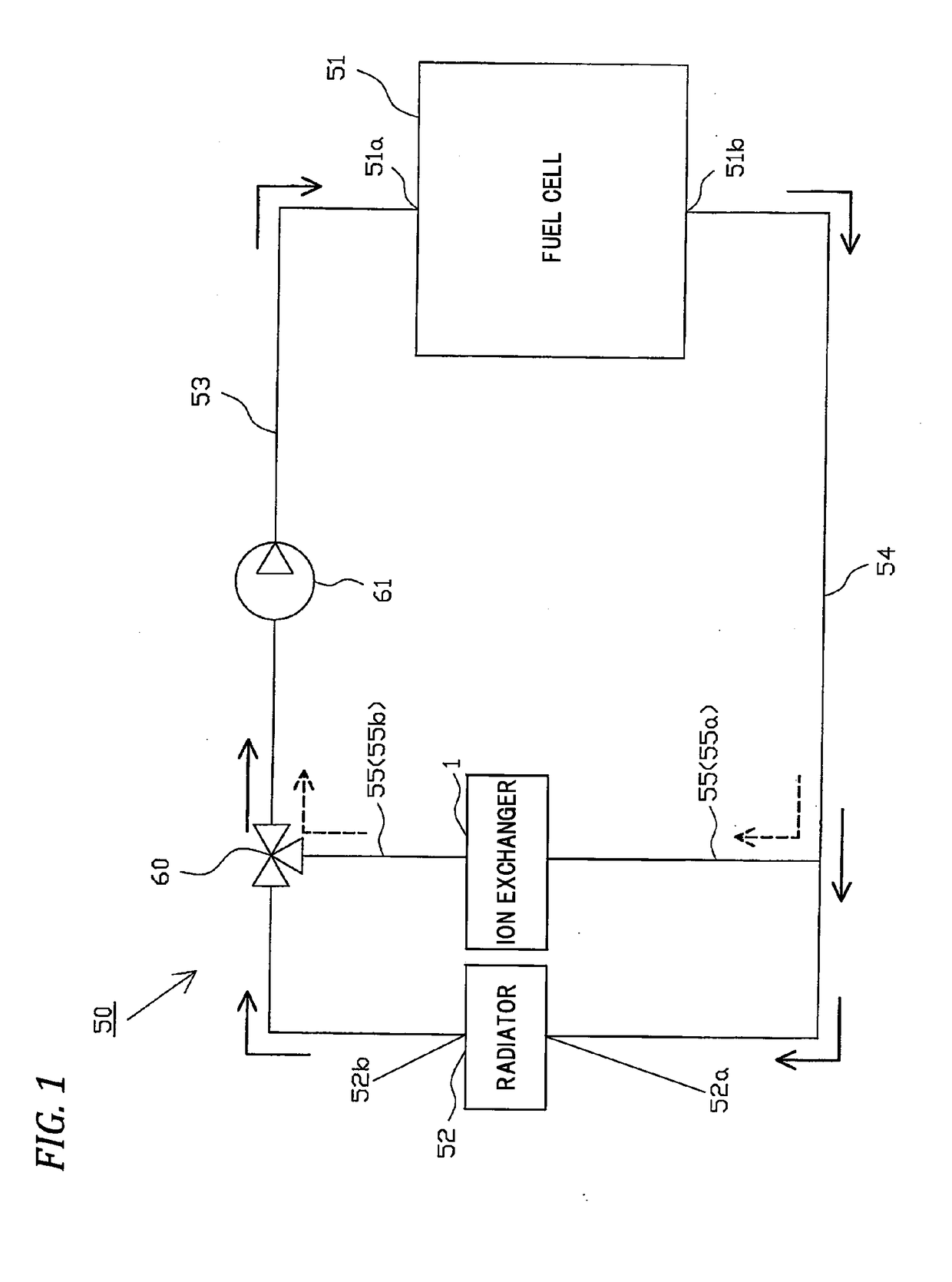Ion exchanger
a technology of ion exchanger and cation exchanger, which is applied in the direction of cation exchanger materials, electrochemical generators, separation processes, etc., can solve the problems of increasing the load of the pump that circulates the coolant, affecting the efficiency of the fuel cell, and causing the leakage of electric energy to the outside of the fuel cell through the coolant, so as to reduce the size of the ion exchanger and shorten the length of the communication tube. ,
- Summary
- Abstract
- Description
- Claims
- Application Information
AI Technical Summary
Benefits of technology
Problems solved by technology
Method used
Image
Examples
first embodiment
[0054]Hereinafter, one embodiment of the invention will be described with reference to the drawings. An ion exchanger according to the invention is, for example, used in a cooling system of a fuel cell system in a fuel cell vehicle. FIG. 1 is a schematic configuration view illustrating a cooling system 50 of the fuel cell system to which an ion exchanger 1 which will be described later is attached.
[0055]As illustrated in FIG. 1, in the cooling system 50, the flow path in which the coolant circulates is mainly configured of an upstream side pipe 53 which connects an inlet port 51a of a fuel cell 51 and an outlet port 52b of a radiator 52 to each other, a downstream side pipe 54 which connects an outlet port 51b of the fuel cell 51 and an inlet port 52a of the radiator 52 to each other, and a bypass pipe 55 connected to the radiator 52, the upstream side pipe 53, and the downstream side pipe 54 in parallel.
[0056]The ion exchanger 1 is installed in the bypass pipe 55, and a three-way v...
second embodiment
[0096]Next, a second embodiment will be described in detail with reference to FIGS. 6 and 7. FIG. 6 is a sectional view illustrating the ion exchanger in the first assembled state according to the embodiment, and FIG. 7 is a sectional view illustrating the ion exchanger in the second assembled state. However, the parts that overlap those in the above-described first embodiment will be given the same reference names and the same reference numbers, the detailed description thereof will be omitted, and the description will focus on parts different from those of the first embodiment hereinafter.
[0097]In the embodiment, in addition to the circumferential wall portion of the inner cylinder portion 4, the opening portion 13 is also formed in the bottom wall portion 10, and the mesh 14 is attached thereto. In addition, in the first assembled state (refer to FIG. 6), the inner cylinder portion 4 is stored such that the lowest part of the bottom wall portion 10 is positioned on the most upstr...
third embodiment
[0102]Next, a third embodiment will be described in detail with reference to FIGS. 8 and 9. FIG. 8 is a sectional view illustrating the ion exchanger in the first assembled state according to the embodiment, and FIG. 9 is a sectional view illustrating the ion exchanger in the second assembled state. However, the parts that overlap those in the above-described first embodiment will be given the same reference names and the same reference numbers, the detailed description thereof will be omitted, and the description will focus on parts different from those of the first embodiment hereinafter.
[0103]In the inner cylinder portion 4, two partition wall portions 11A and 11B are formed to divide the inside into four areas. The partition wall portions 11A and 11B are formed to intersect with each other in a cross-sectional shape in the center axial line C3. In addition, in the first assembled state (refer to FIG. 8), a state is achieved where the partition wall portion 11A is disposed along ...
PUM
| Property | Measurement | Unit |
|---|---|---|
| temperature | aaaaa | aaaaa |
| area | aaaaa | aaaaa |
| temperature | aaaaa | aaaaa |
Abstract
Description
Claims
Application Information
 Login to View More
Login to View More - R&D
- Intellectual Property
- Life Sciences
- Materials
- Tech Scout
- Unparalleled Data Quality
- Higher Quality Content
- 60% Fewer Hallucinations
Browse by: Latest US Patents, China's latest patents, Technical Efficacy Thesaurus, Application Domain, Technology Topic, Popular Technical Reports.
© 2025 PatSnap. All rights reserved.Legal|Privacy policy|Modern Slavery Act Transparency Statement|Sitemap|About US| Contact US: help@patsnap.com



